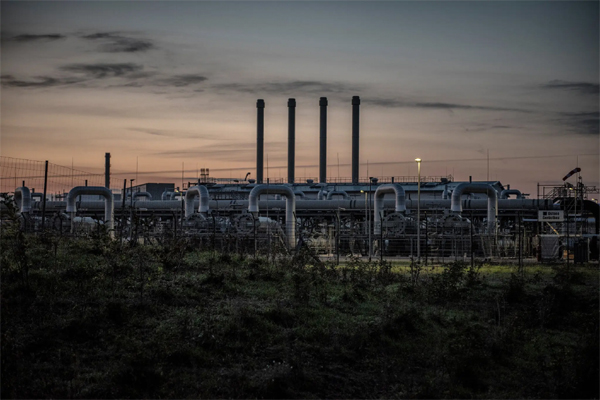As investigators piece together clues, Russia has quietly taken steps to begin expensive repairs on the giant gas pipeline, complicating theories about who was behind September’s sabotage.

Rebecca R. Ruiz and Justin Scheck, NYTimes
LONDON/NEW YORK
EnergiesNet.com 12 27 2022
More than 15 years ago, when the Nord Stream gas pipeline between Russia and Germany was little more than an idea, a Swedish government study warned of the risks inherent in running a critical piece of energy infrastructure along the Baltic Sea floor.
The pipeline would be vulnerable to even the most rudimentary form of sabotage, analysts wrote, and underwater surveillance would be nearly impossible. The 2007 study, written by the Swedish Defense Research Agency, even posited a scenario:
“One diver would be enough to set an explosive device.”
Today, European investigators face almost exactly that scenario. The Swedish authorities leading a criminal investigation have concluded that a state actor was most likely responsible for a September blast that ripped through the gas pipes. Officials and experts say that explosives were probably dropped from ships or — just as the Swedish report warned — planted on the seafloor using submarines or divers.
The Nord Stream attack has been a wartime mystery, prompting finger-pointing and speculation about how — in an era of constant satellite surveillance, in the midst of an energy crisis and with Europe on alert because of the war in Ukraine — a vessel could creep up on a crucial energy conduit, plant a bomb and leave without a trace.
The Baltic Sea, it turns out, was a nearly ideal crime scene. Its floor is latticed with telecommunication cables and pipes that, as had been warned, are not closely monitored. Ships come and go constantly from the nine countries bordering the sea, and vessels can easily hide by turning off their tracking transponders.

“The key question is not what kind of surveillance there was, but why the lack of surveillance for this pipeline — and other pipelines and electric cables and the underwater cables on the seabed,” said Niklas Rossbach, deputy research director at the Swedish Defense Research Agency.
The Baltic is also a giant graveyard for unexploded munitions and chemical weapons dumped after the World Wars. Expeditions to clear those obstacles are common, meaning the expertise to carry out underwater detonation is ubiquitous. Several countries along the Baltic, including Russia, have dive teams that specialize in seabed operations, officials in the region said. Russia, with a port along the Baltic, has small, quiet submarines that can move undetected, according to former military and intelligence officials in the region.
After the blasts, Poland and Ukraine openly blamed Russia but provided no evidence. In an interview, Daniel Stenling, Sweden’s top counterintelligence official, declined to speculate on a perpetrator. But he placed the Nord Stream attack squarely in the context of increasingly brazen Russian espionage.
“In the big context of the war in Ukraine that is ongoing, it’s very interesting and very serious,” he said of the blasts, repeatedly emphasizing growing threats from Russian spycraft and cyberattacks.
“We have seen increased acts from Russia for a long time now,” he said.
Russia, for its part, has blamed Britain, also without evidence.
Russia has a history of using energy to exert influence and has an interest in fracturing alliances within Europe. But the theory that Russia carried out the blasts, repeated often by Western officials, has only gotten more complicated.
In recent weeks, Nord Stream AG, which is majority-owned by a Kremlin-controlled company, has begun pricing out the cost to repair the pipe and restore gas flow, according to a person briefed on the work who spoke on condition of anonymity because he was not authorized to speak about it publicly. One repair estimate starts at about $500 million, the person said. Consultants for Russia are also studying how long the damaged pipes can withstand saltwater exposure. The inquiries raise the question of why, if Russia bombed its own pipelines, it would begin the expensive work of repairing them.

But like any good mystery story, the sabotage has layers of intrigue and multiple players with degrees of motive and ability. Even the decision by the Swedish government to keep details of its inquiry secret from Western allies has prompted whispered speculation that perhaps investigators have cracked the case and are strategically keeping quiet.
Not so, Mr. Stenling said. “We have no concrete evidence,” he said. “But hopefully we will.”
As for his government’s choice to keep its cards close, Mr. Stenling said: “The entire investigation is unusual.”
Nord Stream encompasses two projects, each a pair of concrete-encased steel pipes nearly four feet in diameter and more than 700 miles long.
The first pair, Nord Stream I, came online in 2011. Germany wanted cheap, reliable gas, and Russia wanted to reduce its reliance on piping gas through Ukraine, a country with which it had a contentious relationship long before this year’s invasion.
Just about everyone else in Europe, along with the United States, objected. A senior Polish official even compared the pipeline deal to the pre-World War II pact between Hitler and Stalin that carved up Poland.
Sweden objected to part of the project that was planned near its coastline, arguing that it could enable Russian surveillance.
But the biggest argument was that Nord Stream would make Europe too reliant on Russian gas, giving Moscow a lever over the European Union with its ability to turn off supplies.

Soon after Nord Stream I went online, the Kremlin started pushing for another set of pipes. This second pipeline, known as Nord Stream II, has been even more contentious, with most of the European Union and the United States — under both President Barack Obama and President Donald J. Trump — opposing it.
Construction finished last September and, as Russian soldiers gathered on the border with Ukraine, Ukrainian officials saw the pipeline as a security threat. If Russian gas suppliers could further bypass Ukraine, the argument went, the Kremlin would have no reason not to bomb Ukrainian infrastructure.
Last year, Ukrainian energy regulators sent a 13-page letter to Poland as part of a coordinated effort to stop the new pipeline from coming online. Nord Stream II “will negatively impact on Ukraine’s national security,” read the letter, which was obtained by The New York Times. The letter also warned of economic consequences for Ukraine, since Russian companies still pay to send gas through Ukrainian pipes.
Even after Russia invaded, a Ukrainian government document obtained by The Times shows that Ukraine expected to continue charging Russian companies, including state-owned Gazprom and Rosneft, to transmit gas during the first half of 2022. Under its contract, Ukraine receives an average of $1 billion a year in transit fees.
So the pipelines had no shortage of adversaries.
But sabotaging a key piece of energy infrastructure could be considered an act of war. For a European Union or NATO member to carry it out would have significant consequences, shattering trust in two of the most important Western partnerships. And while attacking the pipeline may have made financial sense for Ukraine, particularly in a time of war, its capability to pull off such a feat is unclear. Ukraine does not have a Baltic port and its only known submarine was captured by Russia in 2014.

Many European governments and experts see Moscow as the most likely saboteur. President Vladimir V. Putin of Russia has used gas as a political lever in the past and there is evidence that he saw Europe as vulnerable.
In one Gazprom meeting, an executive dismissed the idea that Europe could leave Nord Stream II closed. “Wait for one cold winter, and they will beg for our gas,” one official told colleagues at a meeting with Russian policymakers and business executives last year, according to an attendee. The attendee spoke on condition of anonymity because he was not authorized to discuss the meeting.
But Germany blocked Nord Stream II’s launch.
As European countries stockpiled natural gas this year, the Kremlin’s behavior changed. Russia took Nord Stream I offline in late August, blaming mechanical issues. In early September, the Kremlin said that the pipeline would be shut indefinitely. The explosions came a few weeks later, on Sept. 26. They severed both strands of Nord Stream I and one of the Nord Stream II pipes.
The explosion does not neatly benefit Russia. It must keep paying transit fees to Ukraine, it cannot easily use the promise of cheap gas to cleave Germany from its European allies, and it faces hefty repair costs.
But the sabotage all but guarantees that gas prices will be uncomfortably high for Europeans until spring. And it creates an incentive for E.U. countries to push Ukraine to negotiate a quick ending, since the war threatens the land-based pipes that bring gas west. The fact that one of the Nord Stream II pipes remains intact also means that, in an energy crunch, Germany could reverse course and allow that pipe to start pumping gas.
Sabotaging Nord Stream also creates uncertainty about what other infrastructure could be attacked. In addition to damaging the pipeline, the explosion came perilously close to damaging a cable carrying electricity from Sweden to Poland. “You are sending a signal,” said Martin Kragh, deputy director of the Stockholm Center for Eastern European Studies at the nonprofit Swedish Institute of International Affairs. “It’s signaling ‘We can do this, and we can do this elsewhere.’”

The fact that the pipeline was not carrying gas at the time of the explosions has contributed to that speculation.
“We are less certain that the primary aim was functional damage here, because the Nord Stream gas pipeline was not operational at the time,” said Kjell Engelbrekt, who teaches political science at the Swedish Defense University.
(The lack of gas at the time of the explosion also casts serious doubt on a theory that a bomb was sent through the pipe using an inspection device known as a PIG, or pipeline inspection gauge. “Nonsense,” said Stephan Harmsen, who designed the PIG for Nord Stream I. Those devices require gas flow to operate, he said).
Swedish investigators have recovered explosive residue from the blast site. But they have found the Baltic a difficult environment. Undersea photos showed little. Surveillance of such an enormous pipeline would have been incredibly expensive and was never a priority for European intelligence agencies. The best undersea surveillance in the area, security experts say, is by Russian sonar sensors along the pipeline. Western investigators have no access to that data.
With scant evidence from the seabed, a breakthrough may rely on intelligence service wiretaps and human sources. But so far, American and European intelligence agencies have not publicly shared any data that they might have collected.
“It’s very fascinating, but it’s very complex,” Mr. Engelbrekt said. “And it’s very difficult without access to some of these data points to start eliminating actors and motives.”
Rebecca Ruiz is an investigative reporter based in New York. She previously worked for the Washington Bureau, the sports section and the business section. @rebeccaruiz
Justin Scheck is a reporter for The Times working on international investigations. @ScheckNYTimes
A version of this article appears on The NYTimes in print on Dec. 27, 2022, Section A, Page 6 of the New York edition with the headline: A Pipeline Mystery in the Baltic, With a Seabed Ripe for Sabotage.












